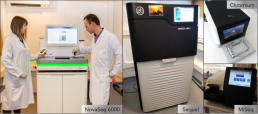Sequencing Platform Genomic Paris Centre – Institut Curie
Introduction
The NGS platform of the Institut Curie set up in 2007 entered into a major development phase in 2012 thanks to an Equipex grant (ICGex for Institut Curie Genomics Excellence). Since then, the facility has been steadily increasing its throughput and expertise and currently carries out the sequencing and analysis of nearly 70Tb of DNA a year, i.e. more than 500 projects.
In direct contact with clinicians and researchers from both the hospital and the research center, the ICGex platform has a major positioning in cancerology (fundamental and translational research) and offers a broad range of applications to address multiple aspects in cancer genomics.
The facility is open to the scientific community in a collaborative mode and proposes its expertise via the France Genomics national network.
Expertise
The platform offers support for sequencing projects including libraries preparation and sequencing but also direct sequencing of libraries prepared by users.
– In genomics, protocols for whole genome sequencing (WGS) or targeted resequencing of the whole exome (WES) and gene panels are implemented and proposed to the community from genomic DNA or circulating DNA.
– In transcriptomics, RNA sequencing (RNAseq) represents a major application, about ten different protocols are supported to address multiple questions and situation. While the majority of projects concern standard protocols targeting mRNAs or total RNAs (after ribodepletion), protocols adapted to degraded samples (FFPE) and small quantities are also supported.
– In epigenomics, the platform proposes ChIP-seq approaches to characterize histone marks and transcription factor binding sites. The platform is also often asked to sequence ATACseq libraries to identify open regions of chromatin and HiC libraries to study the conformation of chromatin within the nucleus.
– In single cell genomics, the facility set up main applications available on the chromium system (10X Genomics): gene expression 3’ et 5’ (scRNAseq), immune profiling(VDJseq), snATACseq as well as multiome which integrates snRNAseq and snATACseq. Spatial transcriptomics based on Visium technology (10X Genomics) is also offered in collaboration with the hospital’s experimental pathology platform (Pathex).
– Concerning the 3rd generation sequencing, the SMRTseq (Single Molecule Real Time SEQuencing) proposed by Pacific Biosciences (PacBio) is available at the platform The Sequel IIe, allows to produce long sequences (10-20kb) of very high quality (HiFi reads technology). . Full-length RNA sequencing protocols (IsoSeq) have been set up as well as genomic approaches for targeted sequencing (capture or amplicons) and whole genome sequencing.
Research and development
The platform is strongly committed to the implementation of HiFi long read sequencing in the field of cancer research. Several proof-of-concept projects are underway concerning the characterisation of SVs in genetic susceptibility to cancer, the research of neoantigens in immunology and of fusion transcripts in cancerology, and the characterisation of viral insertions in tumours. The implementation of the long read on the level of the transcriptome of single cells is also a field of application being developed within the platform.
Bioinformatics
Raw data sequencing files (fastq) and alignment files (bam) are sent to users together with a quality control report in html format.
For exploratory analysis of data, it is possible to contact the bioinformatics platform of the Institut Curie which can offer its services.
Contact : nicolas.servant@curie.fr
Equipments
- 1 Illumina high-throughput sequencers: 1 NovaSeq 6000 dedicated to applications requiring large amount of data
- 2 Illumina benchtop sequencers: 2 MiSeq used for low sequencing depth projects or in the aim of validating new library protocols
- 1 PacBio Long Read Sequencer: 1 Sequel IIe allowing the sequencing of long fragments (>10kb) and repeated sequences
- 1 Genomics 10X Chromium System for single cell analysis
- Several systems for quality control of samples and libraries: 1 LabChip GXII Touch, 1 BioAnalyzer, 1 Femto Pulse, 1 CFX96 real-time PCR system and 1 Pippin Pulse.

Main achievements
– Liu J et al. A high-risk retinoblastoma subtype with stemness features, dedifferentiated cone states and neuronal/ganglion cell gene expression. Nat Commun. (2021) 12(1):5578. PMID: 34552068.
– Bortolini Silveira A et al. Multimodal liquid biopsy for early monitoring and outcome prediction of chemotherapy in metastatic breast cancer. NPJ Breast Cancer. (2021) 7(1):115. PMID: 34504096.
– Surdez D et al. STAG2 mutations alter CTCF-anchored loop extrusion, reduce cis-regulatory interactions and EWSR1-FLI1 activity in Ewing sarcoma. Cancer Cell. (2021) 39(6):810-826.e9.PMID: 33930311.
Gueguen P et al. Contribution of resident and circulating precursors to tumor-infiltrating CD8+ T cell populations in lung cancer. Sci Immunol. (2021) 6(55):eabd5778. PMID: 33514641.
– Chelmicki T et al. m6A RNA methylation regulates the fate of endogenous retroviruses. Nature. (2021) 591(7849):312-316. doi: 10.1038/s41586-020-03135-1.
Last update Nov2021

Labels
IBISA
Medical diagnosis
Platform Managment
Scientist in charge :
Olivier Delattre and Alain Nicolas
Plateform Manager :
Sylvain Baulande
France Genomics Referent :
Sonia LAMEIRAS
Institut Curie, 26 rue d’Ulm 75248 Paris Cedex 05
Contacts
Alain Nicolas : Alain.Nicolas@curie.fr
01 56 24 65 20
Sylvain Baulande : Sylvain.Baulande@curie.fr
01 56 24 67 38

